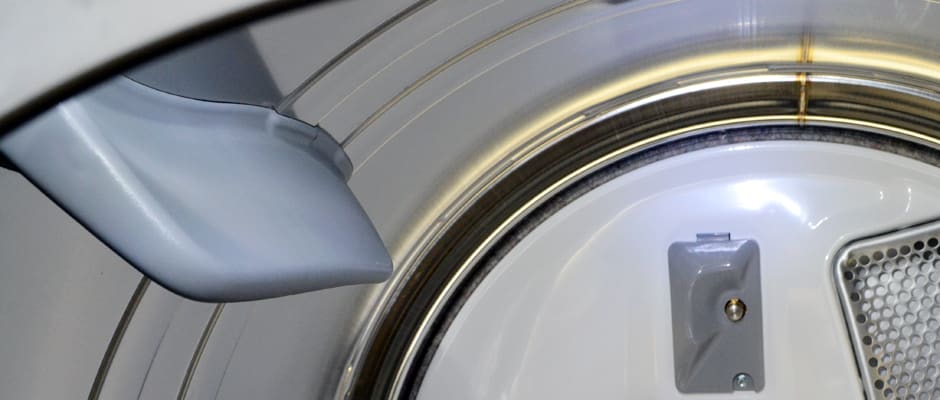Introduction
While you might expect a more expensive version of one appliance to perform better, the 8000 did roughly just as well as its cheaper counterparts. In fact, the only apparent difference between this machine and the 7000 model (whose MSRP is $150 lower) is the inclusion of Maytag's SoundGuard drum.
Design & Usability
Sleek exterior, chunky controls, and catchy tunes.
Unlike the 6000 and the 7000, which are available in something called "cosmetallic," the 8000 is listed on Maytag's site as having a granite finish. We had them all lined up in a row, and let me tell you something folks: they all looked exactly the same. They're gray. Shiny, reflective, and high-end, but still gray. As nice as the machine looks, with its bright control lights and stainless steel drum, the gray—beg pardon, granite—exterior picks up every speck of dust. If that doesn't bother you, than the 8000 is definitely a machine that has style, in a sort of squat, dark, and handsome kind of way.
Some of the labels on the control panel may be a touch too small for some consumers. The size of the font may have something to do with how much is crammed onto the display. The console is rather crowded, but fortunately the white text really pops off the black backdrop.
In terms of basic functionality, the set of dryers resulted in some divided opinions among the review staff. While a few folks found the capacitive touch screen cumbersome, I personally had no complaints. The cycle knob feels good and firm, and turns without a problem. Smooth touchscreen-like buttons were responsive, and each had a cute little chime that went along with it. Turning the machine on and off even caused it to play a little tune. We had wanted to compose a small instrumental piece using the three washers and dryers, but we had difficulty ironing out the recording contract.
{{photo_gallery "Front", "Interior", "Lint Trap", "Cycle Select", "Controls", "Side", "Back"}}
Performance & Features
Mediocre performance doesn't match the price.
What really disappointed us was just how average the MED8000AG really was. Not a single element of its performance merited the $1549 price tag.
True, clothes were completely dry at the end of a Normal cycle, but it got way too hot and lasted too long. They also got completely dry when put through the Delicate cycle, but drying times were also too long here, creeping up towards two hours. Thankfully, that particular setting did what it was supposed to do: drying clothes at a low, gentle heat.
The Rapid Dry and Bedding cycles—our choices for the Quick Dry and Bulky tests—were blatantly ineffective, leaving our test clothes too wet to be usable. These performance qualities aren't anything we haven't seen before; it's the fact that they're coming out of a $1549 dryer that make it disappointing rather than tolerable.
Ten cycle, five temperature settings, and five dryness levels are quite standard, as is the inclusion of assorted steam functions. Extra features such as steam boost, a damp dry signal, and a control lock are nice, but they're all things that can commonly be found on cheaper models.
{{photo_gallery "Cycle Chart"}}
The major factor here, and the only one which differentiates this one from the 7000 model, is Maytag's SoundGuard drum. Supposedly, a special interior will muffle the potentially annoying bangs and clacks made from buttons, zippers, and other metal items. We don't formally test dryers for noise levels, but our naked ears didn't detect $150 worth of sound reduction.
Falling on Deaf Ears
A quiet dryer that failed to catch our ear.
When something as new as the Maytag Maxima XL MED8000AG comes into our labs, we get excited. We'd like to think that a fresh, new product is going to push some boundaries. Unfortunately, this Maytag doesn't really push anything except the limits of someone's wallet. With performance equal to that of a machine nearly half its cost, as well as the features and customizable options of a far more mid-range dryer, there's not a whole lot about this product that should give consumers an incentive to choose it over something else.
Sure, the SoundGuard drum is a nice touch, but without incrementally improved drying capabilities, consumers might as well go with the 6000, more reasonably priced at most retailer sites for about $1000. You can typically find the 8000 online for about $1200, but without the incremental superiority to back it up, you might as well save the $200 and go with the cheaper version.
In the Hot Seat
There were a few minor differences between the performance exhibited by the Maytag Maxima XL MED8000AG compared with its simpler variations, but they were marginal at best. Unfortunately, the basic performance that it played off of wasn't very good to begin with. After running the Maytag through our series of dryer tests, the numbers were clear: it's not as good as the price would make you think.
Normal & Delicate
Too hot and too long.
When it comes to raw drying power, the Maytag's Normal cycle actually succeeded. Clothes came out completely dry, which is usually a good sign. Unfortunately, drying times were longer than is usual, and somewhat inconsistent. Our first test run finished in 70 minutes—already a hair over the norm. The second cycle clocked in at one hour and 26 minutes, well above average. With peak heats reaching a scorching 153.2ºF, clothes are clearly running the risk of becoming over dried.
{{photo_gallery "Normal Test"}}
The Delicate cycle was kinder on clothes, at least. It, too, ran for longer than we usually see, with an average run time of one hour and 44 minutes. Thankfully, temperatures only peaked at 113.4ºF, a much gentler heat. It didn't seem to be warm enough, though; despite the long drying times, clothes finished at 98 percent of the way to their original bone dry weight. Could be worse, could be better.
{{photo_gallery "Delicates Test"}}
Quick Dry & Bulky
Best to stick with Normal.
This Maytag has a designated cycle designed for fast drying of small loads. The 18 minute Rapid Dry cycle got our small test load only 61 percent dry, and with temperatures reaching a cool height of only 122.6ºF, we weren't surprised. The cycle is specifically described in the manual as being ideal for loads of three to four items; needless to say, our standardized 4 lb. load has more than that. We don't alter our loads sizes to maintain consistency from one machine to the next. However, if you use the cycle as directed, you may see better results.
{{photo_gallery "Quick Dry Test"}}
The Bedding cycle used for our Bulky test was similarly disappointing. The only tested sensor-based cycle to run roughly on schedule, the 54 minute cycle could have benefited from some extra drying time. With temperatures reaching just 126.1ºF, our bulky comforter hit 63 percent of its bone dry weight, still far too weight to be usable. Again, it's not the fact that the Maytag failed this test that hurts—we're used to mid-range machines doing poorly here. It's that fact that the Maytag failed and is so expensive that burns our britches.
{{photo_gallery "Bulky Test"}}
Meet the tester
Matthew is a native of Brockton, MA and a graduate of Northeastern, where he earned a degree in English and Theatre. He has also studied at the Gaiety School of Acting in Dublin and spends most of his free time pursuing a performance career in the greater Boston area.
Checking our work.
Our team is here to help you buy the best stuff and love what you own. Our writers, editors, and experts obsess over the products we cover to make sure you're confident and satisfied. Have a different opinion about something we recommend? Email us and we'll compare notes.
Shoot us an email

